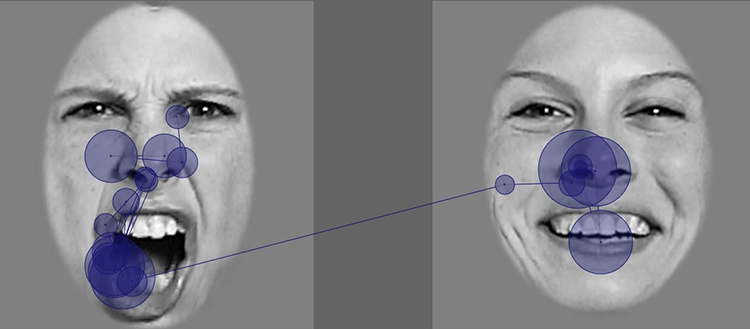Babies make the link between vocal and facial emotion
Can babies really tell the difference between anger and happiness at six months or do they only recognise the physical characteristics of these emotions? UNIGE researchers provide a preliminary answer.

Durations of all ocular fixations of a baby after listening to a voice expressing happiness. The size of the blue areas represents the duration of the ocular fixations and the lines represent the ocular saccades. (UNIGE)
The ability of babies to differentiate emotional expressions appears to develop during their first six months. But do they really recognise emotion or do they only distinguish the physical characteristics of faces and voices? Researchers from the University of Geneva (UNIGE), Switzerland, have just provided an initial answer to this question, measuring the ability of six-month-old babies to make a connection between a voice (expressing happiness or anger) and the emotional expression on a face (again, of happiness or anger). The findings, published in the journal PLOS ONE, show that babies look at an angry face – especially the mouth – for longer if they have previously heard a happy a voice. This reaction to something new demonstrates for the first time that babies have an early ability to transfer emotional information from the auditory mode to the visual.
Emotions form part of our lives from a young age. Expressing emotions is the first tool available to babies for communicating with those around them. Babies express their emotions through their posture, voice and facial expressions from birth. These attitudes help their carers adapt their behaviour to the baby’s emotional state. A baby’s tears, for example, may be an expression of his or her distress and primary needs (to be fed or changed or to lie down). But is the opposite also true, asked UNIGE researchers, led by Professor Edouard Gentaz, president of the Psychology section of the UNIGE’s Faculty of Psychology and Educational Sciences and a member of CISA? Are babies capable of identifying the emotions expressed by adults? Do they adapt their behaviour to fit in with the emotions they are exposed to?
Early skills for discriminating emotions
The ability of babies to differentiate emotional expressions seems to develop in the first six months of life. During this period, new-borns and babies have a preference for smiling faces and happy voices. Prior to six months, they can distinguish happiness from other expressions such as fear, sadness or anger. From seven months onwards, they develop the ability to discriminate between several other facial expressions. It seems, therefore, that babies possess early skills for differentiating between emotions… but do they really recognise them or only distinguish the physical characteristics of faces or voices?
In an attempt to find an answer, 24 six-month-old babies took part in a study at the Geneva BabyLab. They were exposed to voices and faces expressing the emotions of happiness and anger. During a first phase devoted to auditory familiarisation, the babies faced a black screen and listened to a neutral, happy or angry voice for 20 seconds. In the second stage – based on visual discrimination lasting 10 seconds - the babies were placed in front of two emotional faces, one expressing happiness and the other anger.
The research team used eye-tracking technology to measure the baby’s eye movements with great precision. They were then able to determine whether the time spent looking at one or other of the emotional faces – or specific areas of the face (the mouth or eyes) – varied according to the voice they listened to. If the babies looked equally at both faces, it would not be possible to conclude that there was a difference. «On the other hand, if they clearly looked at one of them much longer, we could state that they are able to spot a difference between the two faces,» explains Amaya Palama, a researcher at the Laboratory of Sensorimotor, Affective and Social Development in UNIGE’s Faculty of Psychology and Educational Sciences.
Babies prefer what is new and surprising
The results of the study revealed that six-month-olds did not have a preference for either of the emotional faces if they had already heard a neutral voice or a voice expressing anger. On the other hand, they spent longer looking at the face expressing anger – especially its mouth – after hearing a voice expressing happiness. This visual preference for novelty on the part of six-month-olds testifies of their early ability to transfer emotional information about happiness from the auditory to the visual mode.
Based on this study, we can conclude that six-month-old babies are able to recognise the emotion of happiness regardless of these auditory or visual physical characteristics. This research forms part of a project designed to examine the development of emotional discrimination abilities in childhood funded by the Swiss National Science Foundation (SNSF).
11 Apr 2018